Cyclamen hederifolium
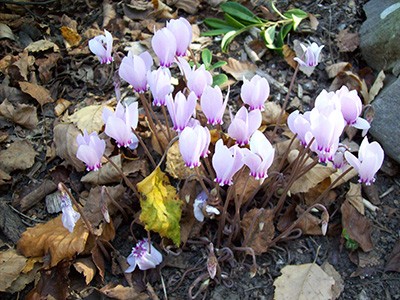 The natural world is filled with fascinating inter-organism relationships that range from detrimental, in the case of parasites or predators, to mutually symbiotic. Parasitism is fascinating in its own right, but I find the relationships that have evolved over millennia that benefit both organisms involved to assist each other are some of the most interesting stories biology can offer. One in particular I am interested in discussing is the phenomenon of Myrmecochory, and particularly as it pertains to the herbaceous perennial species Cyclamen hederifolium.
The natural world is filled with fascinating inter-organism relationships that range from detrimental, in the case of parasites or predators, to mutually symbiotic. Parasitism is fascinating in its own right, but I find the relationships that have evolved over millennia that benefit both organisms involved to assist each other are some of the most interesting stories biology can offer. One in particular I am interested in discussing is the phenomenon of Myrmecochory, and particularly as it pertains to the herbaceous perennial species Cyclamen hederifolium.
Coming from the ancient Greek roots myrmex meaning “ant” and chore meaning “dance,” it literally translates to “ant-dance” or “choreography of ants.” The not-uncommon relationship described is essentially, from a plant’s perspective, the manipulation of ants to carry out a beneficial biological function for the plant. The story, however, starts with the plant.
It should be noted that Cyclamen hederifolium is not the only plant that exhibits myrmecochory, but it sufficiently (and interestingly) serves as an appropriate conduit of explanation. Originally native to the Mediterranean region of southern Europe into western Turkey, Cyclamen hederifolium grows well in medium-dry, partial shade conditions, viably in hardiness zones 5-9.
Foliage follows flowering in early Fall. The leaves are beautifully marbled with silver and white contrasted with dark green and persist through the winter months. The leaf shape roughly resembles that of some species of Hedera ivy, granting the specific epithet hederifolium, directly translating to “ivy-leaf.”
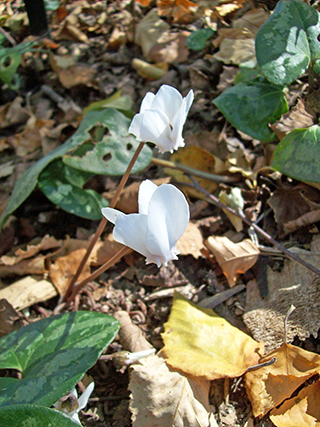
Late-summer emerging flowers have five petals, each of which is reflexed from the downward facing flower, almost giving the suggestion of the ears of a small mammal. photo credit: J. Coceano
A member of the primrose family Primulaceae, the late-summer emerging flowers have five petals, each of which is reflexed from the downward facing flower, almost giving the suggestion of the ears of a small mammal. Each flower petal, at the margins of the point of reflex, exhibits small rounded tube-like protuberant formations that look a little like nostrils. Though not species specific, these formations are often used to assist in keying the species and also add a subtle flare to the ornamental value. The flowers and leaves of C. hederifolium emerge from a subterranean, modified stem (tuber) that resembles, but subtly differs from a corm or bulb, botanically speaking.
In late summer multiple flowers emerge from the tuber and reach an approximate height of 4”-6”, with their faces pointed directly down and petals curved up. Colors range from pale pink to bright fuchsia, usually fading to a deeper pink or purple toward the center of the flower. Following pollination the stem will spiral on itself and coil to the ground wrapping the fertilized seed pod that awaits the early summer for further action.
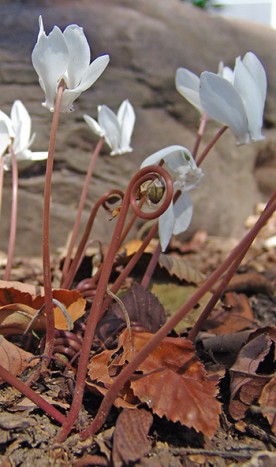
Following pollination, the stem will spiral on itself and coil to the ground wrapping the fertilized seed pod that awaits the early summer for further action. photo credit: R. Manduca
After the leaves go dormant in the summer, the seed pod opens 5-10 flaps peeling back from central point and revealing the seeds in a perfect, ground level cauldron-like structure. At this point comes the long awaited symbiotic choreography of the ant: the small seeds have evolved to produce a fleshy, edible seed coating, called an elaiosome, which is rich with a combination of fats and proteins and is irresistible to ants.
The seeds are small enough for an ant in search of food to gather from the cauldron-like seed pod and carry back to its subterranean nest. In the nest, the elaiosome will be digested to feed the colony, meanwhile the ant is, in effect, simultaneously protecting the seed from predation and safely planting it at a distance from the parent plant, allowing for a very effective dispersal of genetic material, thus creating population diversity and strengthening the gene-pool of the population of Cyclamen in the wild.
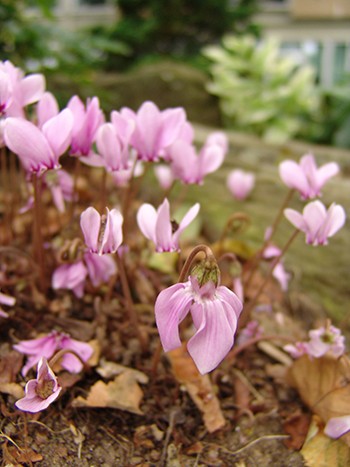
Colors range from pale pink to bright fuchsia, usually fading to a deeper pink or purple toward the center of the flower. photo credit: R. Robert
In the long run, the relationship weighs heavily in the positive for the Cyclamen, but the perennial and reliable food source is also certainly beneficial for ant populations. A healthy specimen of Cyclamen hederifolium can be found in bloom now in the Harry Wood Garden.





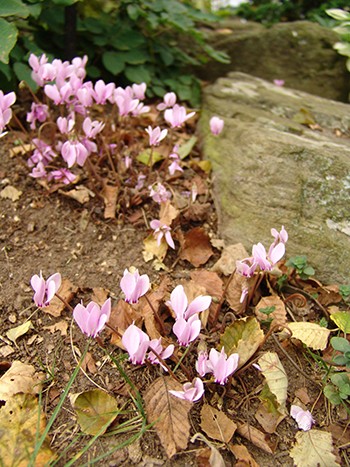
Becky Michael
Posted at 14:03h, 27 OctoberThank you John for the very interesting read. And the pictures are lovely. I’m going to try one of these!
Julie Vrooman
Posted at 19:22h, 27 OctoberI noticed the specimen in the Harry Wood Garden the other day, but was unaware of all the facinating details of its lifecycle. I will pay more attention to these plants in the future.
Carol
Posted at 20:35h, 27 OctoberWow. Thanks for all the articles. This one is my favorite so far!
Virginia White
Posted at 20:44h, 22 JulyThis article was mentioned in the newsletter ‘PestTalks’ with Dr. Chong – very glad he did as it was fascinating. I learned something new to me and I may add some Cyclamen to the garden in the future.
Becky Robert
Posted at 07:43h, 23 JulyDear Virginia, Thank you for the kind words. We love cyclamen and are happy to share the joy of gardening.
Happy Gardening,
Becky Robert
Scott Arboretum